The BMW G 310 R and KTM 390 Duke are both small, compact, agile, well balanced and sufficiently powerful – perfect for the city, and, in the right hands, both bikes can also be fun corner carvers. But, which one does the job better?
The performance motorcycle market is booming at the moment – not just in India, but across the globe. And if there’s one segment that’s growing like never before, it’s that of small-but-not-too-small motorbikes – the sub-400cc segment, to be precise. The KTM 390 Duke is the motorcycle that can be credited for kick-starting the trend of having a powerful and relatively affordable performance motorcycle in India. And, in its new iteration, the KTM has got even more bells and whistles so as to lure in new buyers – especially young buyers. Now, while the KTM has been selling like hot cakes here, BMW Motorrad won’t launch the G 310 R till the end of next year – even though the bike is already being manufactured at the TVS plant in Hosur. Sure, the Germans are a bit late to the party, but they seem to have done their homework.
To each his own
After waiting for a very, very long time post its media launch, the BMW G 310 R finally arrived in showrooms in Europe this summer. The baby BMW features a potent 313cc single cylinder, 4-valve liquid-cooled engine, characterized by its reverse cylinder and 180° rotated head – the intake is in the front and the exhaust in the rear. This is done in order to give the engine more efficient “breathing” characteristics. In addition to that, this orientation also gives a better weight distribution to the motorcycle. As for the specifications, the G 310 R develops 34bhp at 9,500rpm. The chassis is a steel trellis type, the front fork is a 41mm non-adjustable inverted setup and the front-wheel houses a single 300mm radial disc brake along with two-channel ABS. In running order, the motorcycle weighs 158.5kgs. In Europe, it’s priced just over 5,000 Euros, which is substantially less than the KTM 390 Duke’s price tag of 5,800 Euros. In India, though, expect the BMW to be priced slightly higher than the KTM – which has an ex-showroom, Delhi, price of Rs.2.29 lakhs.
Speaking of the KTM, it packs more goodies as compared to the BMW. Its 373cc single-cylinder, four-valve, liquid-cooled engine has more poke – the engine churns out 44bhp at 9,000rpm. Additionally, it gets a new ride-by-wire throttle and slipper clutch. The steel trellis frame is coupled with a non-adjustable 43mm WP fork and a single shock absorber (both revised in their calibration for the weight gain: from 139kgs to 149kgs dry). The braking system is impressive, with a 320mm single front disc.
And what about its looks? Well, it definitely looks beastly – owing to the fact that the little Duke is inspired by the flagship 1290 (nicknamed the “Beast”). The sinister looking front LED headlamp imparts an aggressive demeanour to the motorcycle. Then there’s the beautiful TFT colour instrumentation. There’s also the Bosch 9MP ABS that can be switched off, and can be set up in Supermoto mode (acting only on the front wheel).
Cruel intentions
The KTM seems to scream its warlike intentions to the world. You get this feeling just by looking at it. It’s extroverted and a bit cramped, but it can still be considered elegant and refined – every detail is cautious and styled with extreme care. For example, the wisely hidden cables, well-finished and high-quality plastics, adjustable levers, et al. There are a few niggles though. The riding position is constrained for people taller than 180cm, since you’re crouched and somewhat forced into the saddle with the handlebars too close. For average sized people, it’s alright, but for the tall riders that could be a bit of an issue. The other aspect that could bother you while riding are the vibrations, which are resolute and can be easily felt at highway speeds. Apart from that, the rest of package is deeply impressive. The little Duke is a real, small hooligan who cannot wait to bend itself around corners. It’s hard to resist its enthusiasm because it instigates you to try its guts from the get-go. The engine has lost the roughness of the old unit and it runs much smoother now, even at low speeds. Then, at 7,000rpm, it really shoots ahead! And with that kind of power delivery, and its lightweight body, the 390 Duke can give bigger bikes a run for their money – especially around corners it goes like a flash of lightning. The chassis is super stable and the braking is strong – actually, it’s quite powerful and maybe a bit too aggressive for beginners. The dampening of the suspension is very well calibrated, and when you enter a corner at high speeds, it feels rock solid. However, on the road, you can’t always run it to its full potential. In fact, the Duke is a part of the new KTM philosophy that wants you to enjoy the bike even while strolling around or when it’s being ridden by less experienced riders. The 390 is great value considering its target buyer group. It’s lightweight, the saddle is not that high off the ground (830mm) and the engine and transmission always respond sharply to your inputs. The most impressive thing about the motorcycle is that it’s easily manageable and enjoyable without having to max out its performance.
Lively and elegant
The 390 Duke weighs around 150kgs dry, while the G 310 R also weighs around the same. Yet, when our photographer captured pictures of these two in motion, they both look vastly different in their appeal. Where the KTM is sharp and keen, the BMW has soft design surfaces. For example, the round headlight (non LED) is not as sharp as the KTM, but the saddle is comfortable, spacious and not too high off the ground (785mm), so as to accommodate the rider in a more relaxed manner. But, the quality could have been a bit better – some plastics used are not what we were expecting, the levers are simple and not adjustable, and the instrumentation looks a bit dated already.
That said, once you’re on the move, it feels great. The soft suspension help the small G 310 R feel like a nice and easy motorcycle to potter around in. While the KTM is always anxious to run, the BMW proceeds quickly and fluidly – dismissing potholes and other small obstacles. It’s a far more relaxed motorcycle, but will go as fast if you turn the heat on. The engine delivers power quite smoothly – in the initial phase of the tachometer the engine is still pretty quiet and peaceful. Then, between 7,000 and 8,000rpm, there’s a nice over boost effect (as well as an increase in vibrations on the tank and on the handlebar) all the way to the redline. Despite revving the nuts of the BMW, you’ll notice that the KTM will start pulling ahead – simply owing to the fact that it has around 10 more horsepower.
Easy does it
When you encounter a corner, in the BMW you need to brake a little in advance. The brake lever response is soft, probably done so as to not intimidate new riders. Although the brakes have enough bite, the 310 doesn’t feel ready to attack a corner like the 390. Once you enter the corner and try to push it hard, the suspension sort of lets you know that it doesn’t like that kind of treatment – the weight transfer isn’t all that smooth and it feels a little soft. That said, the motorcycle is planted and maintains the desired line. However, it’s tuned for comfort in comparison to the KTM’s stiffer setup.
The G 310 R’s technology hasn’t evolved like its Austrian rival – the headlamp is not LED and the instrument cluster doesn’t feature a colour display. The engine is inclined rearwards with 180° rotated head, while the exhaust manifold exits from behind.
The swing arm is made of aluminium, and is 650mm long. This helps in achieving more stability, traction and agility. The pillion seat is also soft and spacious, and has two practical grab handles.
The tail of the KTM, which includes two flares – that’s what the passenger has to cling on to. The swing arm has visible ribs. In the photo below, the new look has brought with it a 2.4-litre bigger fuel tank than before. The exhaust system on our test bike is an optional Akrapovic exhaust.
The new full LED light that imitates the 1290 Super Duke.The instrument cluster looks like a tablet. It’s crisp and easy to read. Below, the engine is definitely the main highlight of the 390 Duke. Eager at low rpms and powerful when revved hard.
This is a comparison between the controls. The BMW is cleaner to operate, but navigating through different settings is not that intuitive. With the KTM, however, you control everything from the left
handlebar, including ABS modes.
TESTERS' NOTES
The KTM is the black beast for all the naked sub-400cc bikes out there. Thanks to its larger displacement, it’s the fastest to cover 1,500m. In this comparison, it outperforms the 313cc German in acceleration, which has 10bhp less.
- BMW G 310 R
- KTM 390 Duke
Engine :313cc, single cylinder, liquid cooled, dual overhead cam,4 valves,electronic injection
Transmission :chain driven (16/40), multiplate wet clutch,6-speed gearbox
Rider controlled electronic aids :none
Frame :steel tube trellis frame, aluminium swing arm
Brakes: front: 300mm disc,rear: 240mm disc, ABS
Tyres: front: 110/70-R17, rear: 150/60-R17
Dimensions (mm): length: 2,005, width: 849, wheelbase: 1,374, saddle height: 785, tank: 11 ltr, weight in running order: 158.5kgs
Power & torque: 34bhp @ 9,500rpm, 28Nm @ 7,500rpm
Engine: 373.2cc, single cylinder, liquid cooled, dual overhead cam,4 valves,electronic injection
Transmission: chain driven (15/45),multiplate slipper clutch,6-speed gearbox
Rider controlled electronic aids : ABS 2 levels (plus Off)
Frame : steel tube trellis frame, steel swing arm
Brakes: front: 320mm disc,rear: 230mm disc, ABS
Tyres: front: 110/70-R17,rear: 150/60-R17
Dimensions (mm): length: 2,072,width: 831, wheelbase: 1,357, saddle height: 830,tank: 13.4 ltr, dry weight:149kgs
Power & torque:43.5bhp @ 9,000rpm,37Nm @ 7,000rpm
© Riproduzione riservata






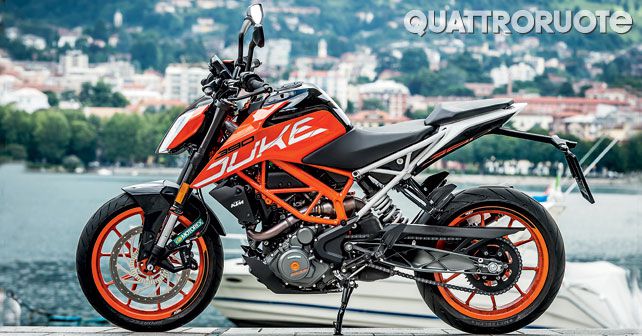













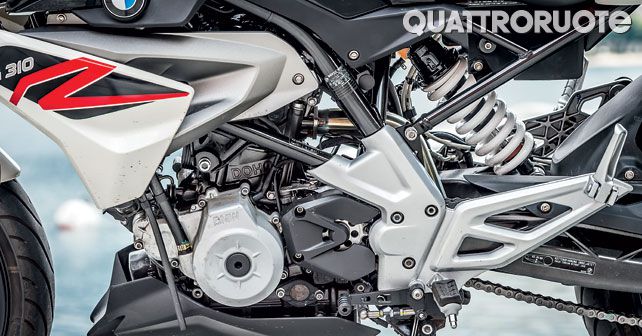












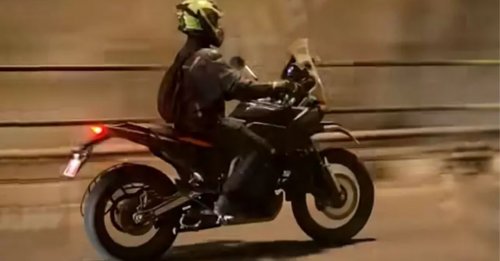
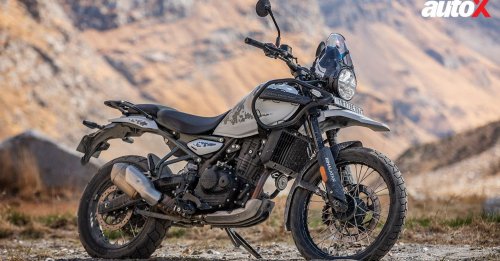


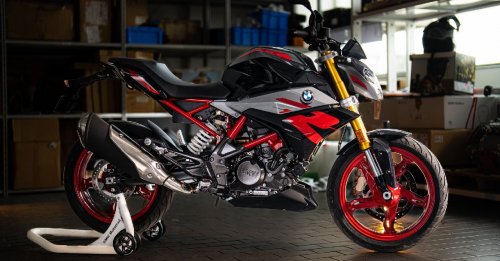














Write your Comment